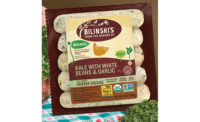CHICKEN
Finding a New Direction
By Megan Pellegrini, contributing writer
Despite a flat year, processors see reasons for optimism.
Compared to historical rates, the chicken category is in a relatively modest growth phase.
After a flat first half of the year, chicken production has rebounded, and overall will be up 0.5 percent for the year, says William Roenigk, senior vice president and chief economist for the Washington, D.C.-based National Chicken Council.
Higher corn prices have forced most producers to ask for higher values at retail — which are up 8.6 percent as of April according to FreshLook Marketing Group — and for now at least consumers are willing to pay the price.
“We’re getting better prices,” says Roenigk, “but supplies are tight.” Even with a diminished supply available, chicken dollar sales increased 6.5 percent as of this spring, reported FreshLook, with foodservice consumption remaining steady. Consumers still look to chicken for convenience, quality, taste and value.
“It’s not difficult to do one of those things, but two or three or all four at the same time is,” says Roenigk. “Companies are looking to build a strong basis going forward and will work along those lines.”
Dan Emery, vice president of marketing for Pilgrim’s Pride Corp., based in Pittsburg, Texas, agrees that consumers are looking for products that can be prepared faster and with more flavor, and notes that value-added products are growing at double-digit rates. “Consumer demands have made us all better,” he says. “We’ve had to figure out how to lower our costs, make products more convenient and healthy.”
He adds that wings and breast products remain popular. Aging boomers and empty nesters are driving changes with packaging, as packages now have increased utility and resealability for smaller, two-person households. This year, Pilgrim’s Pride launched its Fridge-to-Freezer Pak to enable consumers to take out and prepare one serving of chicken at a time. And tray/pouch combinations and stand-up pouches are hitting shelves, such as Tyson’s Oven Roasted Chicken line.
A new direction
Consumers are also willing to pay more for natural and all-natural products, says Roenigk, but remain ambivalent about organic chicken. However, confusion still exists among consumers as to the USDA’s definition of natural meat, with many mistakenly assuming these cattle or poultry are raised without antibiotics. Consequently, Roenigk says many chicken processors are taking consumers’ lead on this issue and raising chickens antibiotic-free, instead of waiting for the government to update its definition of naturals.
Brands are also telling a story. In addition to putting a brand name on a label, more companies are relating how their families came to be in the chicken business, how they raise their chickens, address food safety and animal-welfare issues. Following the locally grown trend, others are putting the name of the local farmer who raised the product on the label to build a better linkage between the consumer and his food.
“There is a perception that locally grown foods are fresher and don’t use as much energy to go to market,” says Roenigk.
Although Roenigk doesn’t see any new breakthrough products on the horizon, such as chicken nuggets, patties and gourmet sausage, he points out that coarsely ground chicken is slowly making inroads in the ground meat category and chicken leg quarters are gaining ground on restaurant menus.
| Annual Broiler Forecasts | |||||
| 2004 | 2005 | 2006 | 2007 | 2008 | |
| Production (millions lbs.) | 34,063 | 35,365 | 35,752 | 35,699 | 36,525 |
| Per capita disappearance* (retail lb.) | 84.2 | 85.6 | 86.9 | 85.8 | 85.9 |
| Broiler exports (millions lbs.) | 4,784 | 5,203 | 5,272 | 5,250 | 5,515 |
| *Per capita meat consumption data are revised, incorporating a new population series from the Commerce Department’s Bureau of Economic Analysis based on the 2000 Census. Source: World Agricultural Supply and Demand Estimates and Supporting Materials Published in Livestock, Dairy, and Poultry Outlook, www.ers.usda.gov/publications/ldp | |||||




Report Abusive Comment